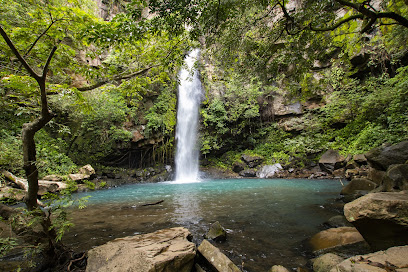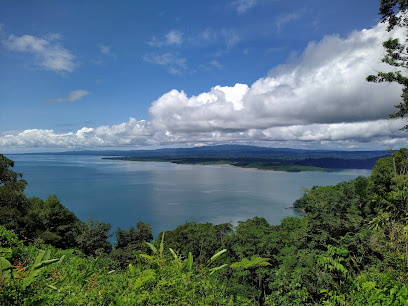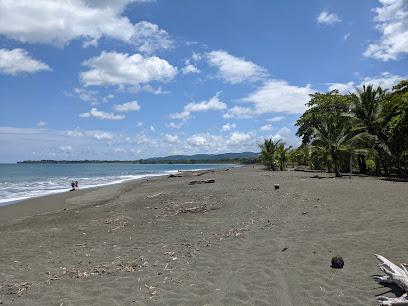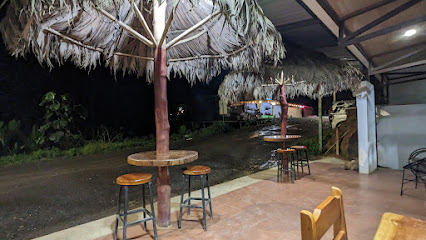
Corcovado National Park: Nature's Untamed Paradise
Discover the wild beauty of Corcovado National Park in Costa Rica, a biodiverse wonderland teeming with exotic wildlife, lush rainforests, and pristine beaches.
Corcovado National Park, located on the Osa Peninsula in Costa Rica, is a must-visit for nature lovers and adventure seekers alike. This biodiverse haven is home to 13 different ecosystems, including rainforests, swamps, and beaches. Walking through Corcovado, you will encounter a variety of wildlife, from the elusive jaguar to playful monkeys and colorful macaws. One of the park's main attractions is the Sirena Biological Station, a remote outpost where you can stay overnight and experience the jungle's nocturnal wonders. The park also features numerous hiking trails, each offering unique views and experiences. Whether you are trekking through dense forests or strolling along pristine beaches, the natural beauty of Corcovado will leave you in awe. The park is also renowned for its marine life. Snorkeling and diving opportunities abound, allowing you to explore vibrant coral reefs and encounter species such as dolphins and sea turtles. With its remarkable biodiversity and stunning landscapes, Corcovado National Park offers an unforgettable experience for any visitor.
Local tips in Corcovado National Park
- Book guided tours in advance to make the most of your visit.
- Wear comfortable, waterproof shoes for hiking.
- Pack insect repellent and sunscreen.
- Bring a reusable water bottle to stay hydrated.
- Respect wildlife by maintaining a safe distance.
Corcovado National Park: Nature's Untamed Paradise
Corcovado National Park, located on the Osa Peninsula in Costa Rica, is a must-visit for nature lovers and adventure seekers alike. This biodiverse haven is home to 13 different ecosystems, including rainforests, swamps, and beaches. Walking through Corcovado, you will encounter a variety of wildlife, from the elusive jaguar to playful monkeys and colorful macaws. One of the park's main attractions is the Sirena Biological Station, a remote outpost where you can stay overnight and experience the jungle's nocturnal wonders. The park also features numerous hiking trails, each offering unique views and experiences. Whether you are trekking through dense forests or strolling along pristine beaches, the natural beauty of Corcovado will leave you in awe. The park is also renowned for its marine life. Snorkeling and diving opportunities abound, allowing you to explore vibrant coral reefs and encounter species such as dolphins and sea turtles. With its remarkable biodiversity and stunning landscapes, Corcovado National Park offers an unforgettable experience for any visitor.
When is the best time to go to Corcovado National Park?
Iconic landmarks you can’t miss
Braulio Carrillo National Park
Discover the stunning biodiversity and breathtaking landscapes of Braulio Carrillo National Park, a natural paradise in Costa Rica.

Parque Nacional Rincón de la Vieja
Explore the stunning landscapes and diverse wildlife of Parque Nacional Rincón de la Vieja in Costa Rica's Guanacaste Province for an unforgettable adventure.

Parque Nacional Los Quetzales
Experience the breathtaking beauty and rich biodiversity of Parque Nacional Los Quetzales in Costa Rica, a paradise for nature lovers and birdwatchers alike.

Parque Nacional Corcovado
Explore Corcovado National Park, a biodiversity hotspot in Costa Rica's Puntarenas Province, rich in wildlife and breathtaking natural beauty.

Corcovado National Park - San Pedrillo Ranger Station
Experience the breathtaking biodiversity and stunning landscapes of Corcovado National Park at the San Pedrillo Ranger Station, a must-visit for nature lovers.

Corcovado, estación Sirena National Park
Experience the untouched beauty of Corcovado National Park and explore the biodiversity of Costa Rica's natural paradise.

Corcovado National Park - El Tigre Trail
Explore the breathtaking beauty of Corcovado National Park's El Tigre Trail, a paradise for wildlife enthusiasts and hiking adventurers in Costa Rica.

Corcovado National Park - Sirena and San Pedrillo Ranger Station
Discover the breathtaking biodiversity and stunning landscapes of Corcovado National Park's Sirena and San Pedrillo Ranger Stations in Costa Rica.

Unmissable attractions to see
Reserva Forestal Golfo Dulce
Discover the breathtaking beauty of Reserva Forestal Golfo Dulce, a nature preserve in Costa Rica rich in biodiversity and adventure.

Cascada El Pavón
Experience the breathtaking beauty of Cascada El Pavón, a stunning waterfall in Puntarenas Province, Costa Rica, perfect for nature lovers and adventure seekers.

Parque de Las Esferas
Explore Parque de Las Esferas, a unique blend of art and nature in Palmar Sur, Costa Rica, featuring enigmatic sculptures and lush landscapes.

Sitio Arqueológico Batambal
Discover the rich history and stunning nature at Sitio Arqueológico Batambal, an archaeological gem in Costa Rica offering a glimpse into the pre-Columbian era.

Punta Rio Claro National Wildlife Refuge
Explore Punta Rio Claro National Wildlife Refuge, a breathtaking sanctuary of biodiversity and natural beauty in the heart of Costa Rica's Osa Peninsula.

Waterfall and hidden natural pools
Explore the breathtaking waterfalls and serene natural pools in Uvita, Costa Rica, a must-visit destination for nature lovers and adventurers.

King Louis Waterfall
Experience the beauty and tranquility of King Louis Waterfall, a stunning natural gem in Costa Rica's lush Puntarenas Province.

Playa Preciosa
Explore the tranquil beauty of Playa Preciosa in Costa Rica, a nature preserve showcasing pristine beaches and lush landscapes, perfect for relaxation and adventure.

Osa Canyoning Adventures
Experience the thrill of canyoning in Costa Rica's pristine landscapes with Osa Canyoning Adventures - a unique adventure for nature and adrenaline lovers.

Corcovado National Park - El Tigre Trail
Explore the breathtaking biodiversity of Corcovado National Park's El Tigre Trail, a Costa Rican gem for nature lovers and adventurers alike.

Osa WildLife Sanctuary
Explore the Osa Wildlife Sanctuary in Costa Rica, an eco-friendly haven for rescued wildlife and an educational experience in rich biodiversity.

Campanario Biological Station
Explore the rich biodiversity and natural beauty of Campanario Biological Station in Costa Rica's Osa Peninsula, a paradise for eco-tourists and nature enthusiasts.

Osa Outdoors Adventures
Discover thrilling outdoor adventures in Drake Bay, Costa Rica, with Osa Outdoors Adventures – your gateway to nature's wonders.

Estación Los Planes, Parque Nacional Corcovado
Explore Estación Los Planes in Parque Nacional Corcovado, Costa Rica's premier destination for biodiversity and natural beauty.

Corcovado Expeditions
Experience the remarkable biodiversity of Corcovado Expeditions in Costa Rica, where adventure meets conservation in a stunning tropical paradise.

Essential places to dine
Hotel Restaurante Bella Vista Corcovado
Experience breathtaking views and authentic Costa Rican cuisine at Hotel Restaurante Bella Vista Corcovado – your gateway to nature's paradise.

Finca Bijagual
Experience the perfect blend of exquisite cuisine and nature at Finca Bijagual in Costa Rica's stunning Osa Peninsula.

Markets, malls and hidden boutiques
Parque Nacional Corcovado
Discover the breathtaking biodiversity and pristine landscapes of Parque Nacional Corcovado, a must-visit national park in Costa Rica.

BM Jiménez
Experience the essence of Costa Rican culture at BM Jiménez, your friendly neighborhood supermarket in Puerto Jiménez, Puntarenas.

Sirena Ranger Station
Explore the breathtaking biodiversity of Costa Rica at Sirena Ranger Station, your gateway to adventure in Corcovado National Park.

Corcovado Hiking Tours
Discover the breathtaking beauty of Costa Rica's Corcovado National Park with Corcovado Hiking Tours, a premier adventure for nature lovers.

Corcovado National Park - San Pedrillo Ranger Station
Discover the breathtaking biodiversity of Corcovado National Park at San Pedrillo Ranger Station, where adventure and nature await in Costa Rica.

Abastesedor Daniel Dixon
Discover unique home goods and local crafts at Abastesedor Daniel Dixon, a charming store in Cañaza Puerto Jimenes de Osa, Costa Rica.

Caño Divers
Explore the vibrant marine life and stunning underwater landscapes at Caño Divers in the breathtaking Peninsula de Osa, Costa Rica.

Sea Star Souvenir
Discover unique Costa Rican souvenirs at Sea Star Souvenir in Brasilito, where local artistry and environmental consciousness come together.

Minisuper Puerto Escondido
Experience local convenience at Minisuper Puerto Escondido, your go-to grocery for fresh produce and Costa Rican snacks.

Souvenir Ocarina
Explore Souvenir Ocarina in Liberia, Costa Rica - your destination for authentic local crafts and unique keepsakes that capture the essence of your travels.

Osa Great Adventure
Discover the breathtaking beauty of Costa Rica's Osa Peninsula with Osa Great Adventure, your premier tour operator for unforgettable outdoor experiences.

OSACOOP R.L.
Explore OSACOOP R.L. in Puerto Jiménez: Shop sustainably and support local artisans in a vibrant Costa Rican community.

Super mercado la violeta #2
Discover authentic local products and immerse yourself in Costa Rican culture at Supermercado La Violeta #2 in Puerto Jiménez.

Coco osa Carate
Experience the vibrant local culture and flavors at Coco Osa Carate, a must-visit kiosk in Puntarenas Province, Costa Rica.

Corcovado National Park - Sirena and San Pedrillo Ranger Station
Discover the unmatched biodiversity and breathtaking scenery of Corcovado National Park, a must-visit for every nature lover in Costa Rica.

Essential bars & hidden hideouts
DinerCraft Bar & Restaurant
Discover the authentic taste of Costa Rica at DinerCraft Bar & Restaurant in Drake Bay, where local flavors meet stunning natural beauty.

Bar y Restaurante Chicharronera El Cedro
Discover the authentic flavors of Costa Rica at Bar y Restaurante Chicharronera El Cedro, a lively bar and restaurant in Puerto Jiménez.

Bar La Jungla
Discover the vibrant atmosphere and local flavors at Bar La Jungla in Rancho Quemado, a must-visit bar for tourists in Costa Rica.

Bar Rincon El Puente
Discover the vibrant atmosphere and authentic flavors at Bar Rincon El Puente, a must-visit bar in the heart of Osa, Costa Rica.

Bar los amigos
Experience the vibrant nightlife of Palma at Bar Los Amigos, where tropical cocktails and lively music create unforgettable memories.

Ficus Bar
Experience the lively ambiance and local flavors at Ficus Bar in Rancho Quemado, your perfect retreat in Costa Rica's Puntarenas Province.

Sunset Paradise Restaurant
Experience the flavors of Costa Rica at Sunset Paradise Restaurant, where every meal is accompanied by breathtaking sunset views and a warm atmosphere.

The Jaguar's Jungle Restaurant
Discover the flavors of Costa Rica in a serene jungle setting at The Jaguar's Jungle Restaurant, a perfect blend of nature and local cuisine.

Amayas de Osa
Experience the vibrant flavors and serene ambiance of Amayas de Osa, a tropical bar and restaurant nestled in the heart of Costa Rica's natural beauty.

Bar El Ranchito Bahia Chal Osa
Experience the vibrant atmosphere and authentic local flavors at Bar El Ranchito Bahia Chal Osa in Puntarenas Province.

Sukia Lounge Bar & Cafe
Discover the flavors of Costa Rica at Sukia Lounge Bar & Cafe in Agujitas, where delicious cuisine meets a stunning tropical backdrop.

Bar y restaurante los malinches
Experience the authentic flavors of Costa Rica at Bar y Restaurante Los Malinches, where local cuisine meets vibrant atmosphere in Osa.

Sonia's bar krustaceo kascarudo
Experience the vibrant coastal culture at Sonia's Bar in Osa, where delightful seafood meets breathtaking ocean views.

Jordy’s Bar
Experience the vibrant nightlife and welcoming atmosphere at Jordy’s Bar in Puerto Jiménez, your perfect retreat after exploring the stunning Osa Peninsula.

El Garaje
Experience the vibrant atmosphere of El Garaje, Puerto Jiménez’s favorite bar for locals and tourists alike, offering refreshing drinks and live music.

Local Phrases about Corcovado National Park
-
- HelloHola
[oh-la] - GoodbyeAdiós
[ah-dee-ohs] - YesSí
[see] - NoNo
[noh] - Please/You're welcomePor favor/De nada
[por fah-bor/deh nah-dah] - Thank youGracias
[grah-see-ahs] - Excuse me/SorryDisculpe/Perdón
[dee-skool-peh/pehr-dohn] - How are you?¿Cómo estás?
[koh-moh ehs-tahs] - Fine. And you?Bien. ¿Y tú?
[byen. ee too] - Do you speak English?¿Hablas inglés?
[ah-blahs een-glehs] - I don't understandNo entiendo
[noh ehn-tee-ehn-doh]
- HelloHola
-
- I'd like to see the menu, pleaseMe gustaría ver el menú, por favor
[meh goo-stah-ree-ah behr ehl meh-noo, por fah-bor] - I don't eat meatNo como carne
[noh koh-moh kahr-neh] - Cheers!¡Salud!
[sah-lood] - I would like to pay, pleaseMe gustaría pagar, por favor
[meh goo-stah-ree-ah pah-gahr, por fah-bor]
- I'd like to see the menu, pleaseMe gustaría ver el menú, por favor
-
- Help!¡Ayuda!
[ah-yoo-dah] - Go away!¡Vete!
[veh-teh] - Call the Police!¡Llama a la policía!
[yah-mah ah lah poh-lee-see-ah] - Call a doctor!¡Llama a un médico!
[yah-mah ah oon meh-dee-koh] - I'm lostEstoy perdido/a
[ehs-toy pehr-dee-doh/dah] - I'm illEstoy enfermo/a
[ehs-toy ehn-fehr-moh/ah]
- Help!¡Ayuda!
-
- I'd like to buy...Me gustaría comprar...
[meh goo-stah-ree-ah kohm-prahr] - I'm just lookingSolo estoy mirando
[soh-loh ehs-toy meer-ahn-doh] - How much is it?¿Cuánto cuesta?
[kwan-toh kwehs-tah] - That's too expensiveEsto es demasiado caro
[ehs-toh ehs deh-mah-syah-doh kah-roh] - Can you lower the price?¿Puede bajar el precio?
[pweh-deh bah-har ehl pree-syoh]
- I'd like to buy...Me gustaría comprar...
-
- What time is it?¿Qué hora es?
[keh oh-rah ehs] - It's one o'clockEs la una
[ehs lah oo-nah] - Half past (10)Las diez y media
[lahs dyehs ee meh-dee-ah] - MorningMañana
[mah-nyah-nah] - AfternoonTarde
[tahr-deh] - EveningNoche
[noh-cheh] - YesterdayAyer
[ah-yehr] - TodayHoy
[oy] - TomorrowMañana
[mah-nyah-nah] - 1Uno
[oo-noh] - 2Dos
[dohs] - 3Tres
[trehs] - 4Cuatro
[kwah-troh] - 5Cinco
[seen-koh] - 6Seis
[says] - 7Siete
[syeh-teh] - 8Ocho
[oh-choh] - 9Nueve
[nweh-veh] - 10Diez
[dyehs]
- What time is it?¿Qué hora es?
-
- Where's a/the...?¿Dónde está...?
[dohn-deh ehs-tah] - What's the address?¿Cuál es la dirección?
[kwal ehs lah dee-rehk-syon] - Can you show me (on the map)?¿Puede mostrarme (en el mapa)?
[pweh-deh mohs-trar-meh (ehn ehl mah-pah)] - When's the next (bus)?¿Cuándo es el próximo (autobús)?
[kwan-doh ehs ehl proh-ksy-moh (ow-toh-boos)] - A ticket (to ....)Un boleto (a ...)
[oon boh-leh-toh (ah)]
- Where's a/the...?¿Dónde está...?
History of Corcovado National Park
-
Long before the arrival of Europeans, the region that is now Corcovado National Park was home to indigenous tribes such as the Diquís. These pre-Columbian inhabitants are renowned for their advanced social structures and impressive craftsmanship, particularly in goldsmithing. The Diquís were known for creating intricate gold artifacts and stone spheres, some of which have been found within the park boundaries, offering a glimpse into their sophisticated culture.
-
In the early 16th century, Spanish explorers arrived in what is now Costa Rica, marking the beginning of a significant shift in the region's history. The Spanish conquest led to the colonization of Costa Rica, and the indigenous populations were drastically affected by diseases, forced labor, and cultural changes. Although the dense rainforests of the Osa Peninsula, where Corcovado is located, remained largely unexplored by the Spanish, the influence of colonization eventually reached these remote areas.
-
The 1930s and 1940s witnessed a gold rush in the Osa Peninsula, drawing prospectors from all over Costa Rica and beyond. The promise of riches led to extensive mining activities in the region, which significantly impacted the local environment. Rivers were dredged, and forests were cleared as miners scoured the land for gold. This period of intense activity left a lasting mark on the landscape and the local communities.
-
Corcovado National Park was established in 1975 by the Costa Rican government, in response to growing concerns about the environmental degradation caused by logging, mining, and agriculture. The park was created to protect the unique biodiversity and ecosystems of the Osa Peninsula. Covering over 164 square miles, Corcovado is one of the largest and most biologically intense lowland rainforests in Central America. Its establishment marked a significant step in Costa Rica's commitment to conservation and sustainable tourism.
-
Since its establishment, Corcovado National Park has faced numerous conservation challenges, including illegal logging, poaching, and gold mining. The Costa Rican government, along with various non-governmental organizations, has implemented several measures to combat these threats. These efforts include increased patrolling, stricter enforcement of environmental laws, and community-based conservation programs. Ecotourism has also played a crucial role in funding conservation initiatives and raising awareness about the importance of preserving this unique ecosystem.
-
The region surrounding Corcovado National Park holds significant cultural importance for the indigenous communities that still reside there. Groups such as the Boruca, Bribri, and Cabécar continue to maintain their traditional ways of life, despite the pressures of modernization. These communities contribute to the cultural richness of the area, offering visitors an opportunity to learn about their customs, beliefs, and sustainable practices. Their presence underscores the deep-rooted connection between the land and its original stewards.
Corcovado National Park Essentials
-
Corcovado National Park is located on the Osa Peninsula in southwestern Costa Rica. The nearest international airport is Juan Santamaria International Airport in San Jose. From San Jose, you can take a domestic flight to Puerto Jimenez or Drake Bay, which are the closest towns to the park. Alternatively, you can take a bus or rent a car for a scenic drive. The journey by road typically takes around 6-8 hours.
-
Within Corcovado National Park, transportation options are limited to hiking and boat rides, as no vehicles are allowed inside the park. Local guides are available and recommended for navigating the park’s trails. For getting around the Osa Peninsula, taxis and rental cars are available in Puerto Jimenez and Drake Bay. Boat services also connect various points along the coast.
-
The official currency in Costa Rica is the Costa Rican Colón (CRC). Credit cards are widely accepted in hotels, restaurants, and shops in Puerto Jimenez and Drake Bay. However, it is advisable to carry cash for smaller establishments and when entering the park. ATMs are available in the towns, but not inside the park.
-
Corcovado National Park is generally safe for tourists, but standard precautions should be taken. Petty theft can occur, so keep an eye on your belongings and avoid leaving valuables unattended. Be cautious when hiking and always follow the advice of local guides. Some areas around the park, particularly remote beaches, can be risky at night, so it's best to avoid these areas after dark.
-
In case of emergency, dial 911 for immediate assistance. Medical facilities are available in Puerto Jimenez and Drake Bay. It is highly recommended to have travel insurance that covers medical emergencies, including evacuation. Park rangers are present in Corcovado National Park and can assist in case of emergencies. For minor health issues, there are pharmacies in the nearby towns.
-
Fashion: Do wear lightweight, breathable clothing and sturdy hiking boots. Don’t wear flip-flops or open-toed shoes on trails. Religion: Costa Rica is predominantly Catholic, but the park area is secular. Respect local customs in nearby towns if visiting religious sites. Public Transport: Do be patient with the limited transport options and schedules. Don’t expect punctuality. Greetings: Do greet people with a friendly 'Hola' or 'Buenos días.' A handshake is also common. Eating & Drinking: Do try local dishes such as Gallo Pinto and fresh seafood. Don’t drink tap water; always opt for bottled or purified water.
-
To experience Corcovado National Park like a local, consider hiring a local guide who can offer insights into the park’s biodiversity and hidden spots. Visit the park early in the morning for the best wildlife sightings. Engage with locals in Puerto Jimenez and Drake Bay to learn more about the region's culture and history. Don't miss the chance to try local fruits and freshly caught fish at local markets and eateries.
Trending Landmarks in Corcovado National Park
-
Braulio Carrillo National Park
-
Parque Nacional Rincón de la Vieja
-
Parque Nacional Los Quetzales
-
Parque Nacional Corcovado
-
Corcovado National Park - San Pedrillo Ranger Station
-
Corcovado, estación Sirena National Park
-
Corcovado National Park - El Tigre Trail
-
Corcovado National Park - Sirena and San Pedrillo Ranger Station
Nearby Cities to Corcovado National Park
-
Things To Do in Manuel Antonio
-
Things To Do in David
-
Things To Do in Boquete
-
Things To Do in Puerto Viejo
-
Things To Do in San Jose
-
Things To Do in Jaco
-
Things To Do in Bocas del Toro
-
Things To Do in Monteverde
-
Things To Do in La Fortuna
-
Things To Do in Guanacaste
-
Things To Do in Liberia
-
Things To Do in Tamarindo
-
Things To Do in Playa Flamingo
-
Things To Do in Chitre
-
Things To Do in Las Tablas











